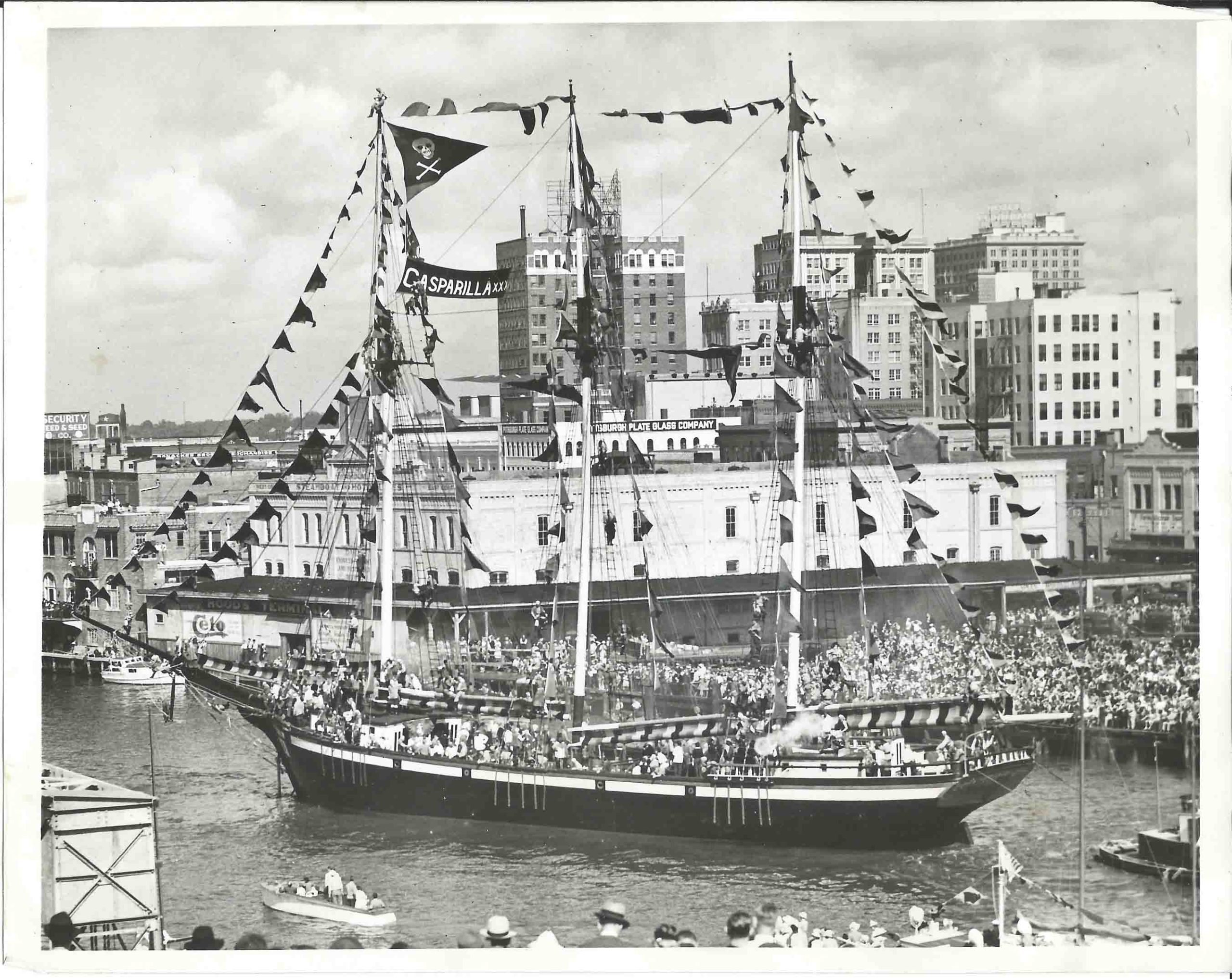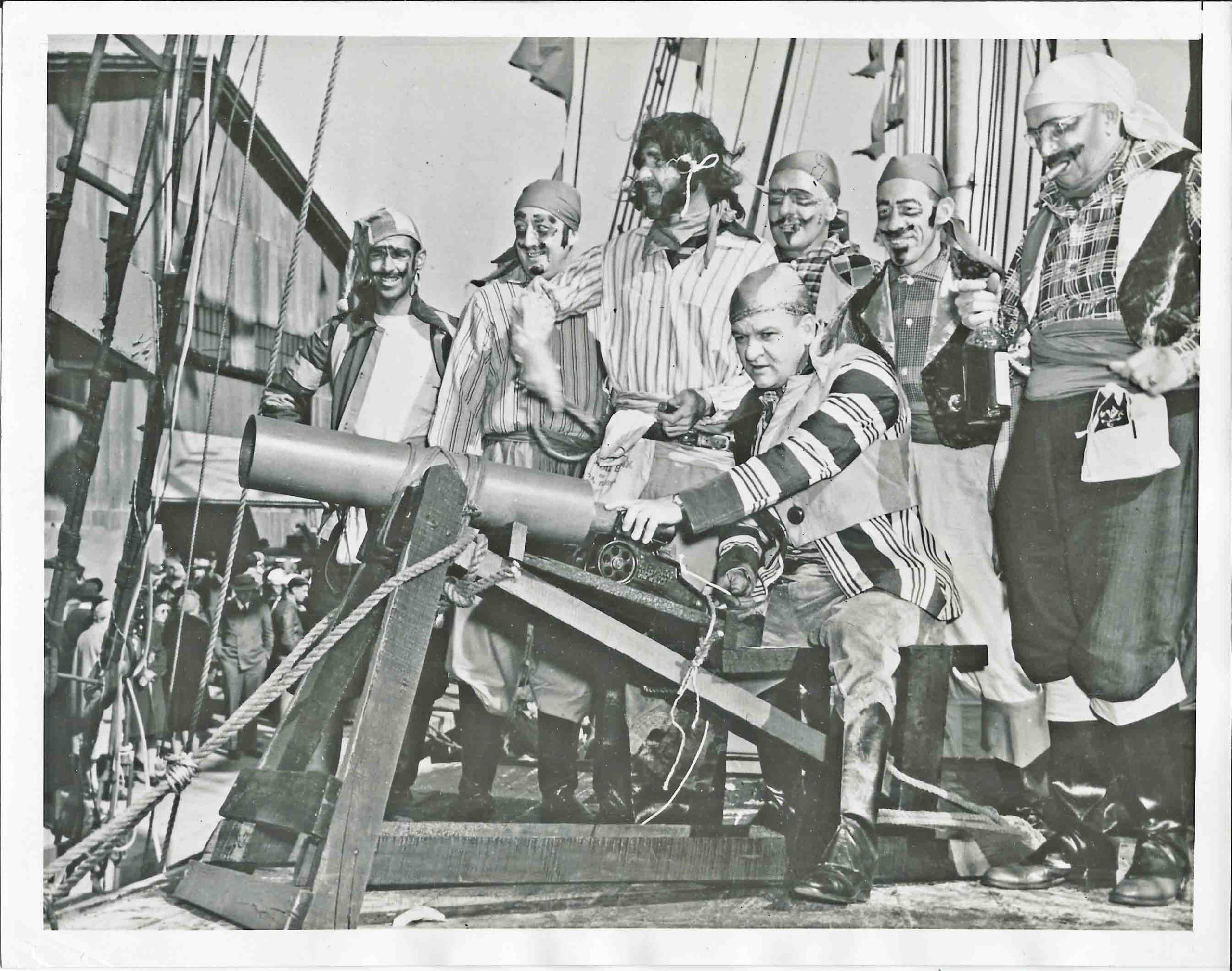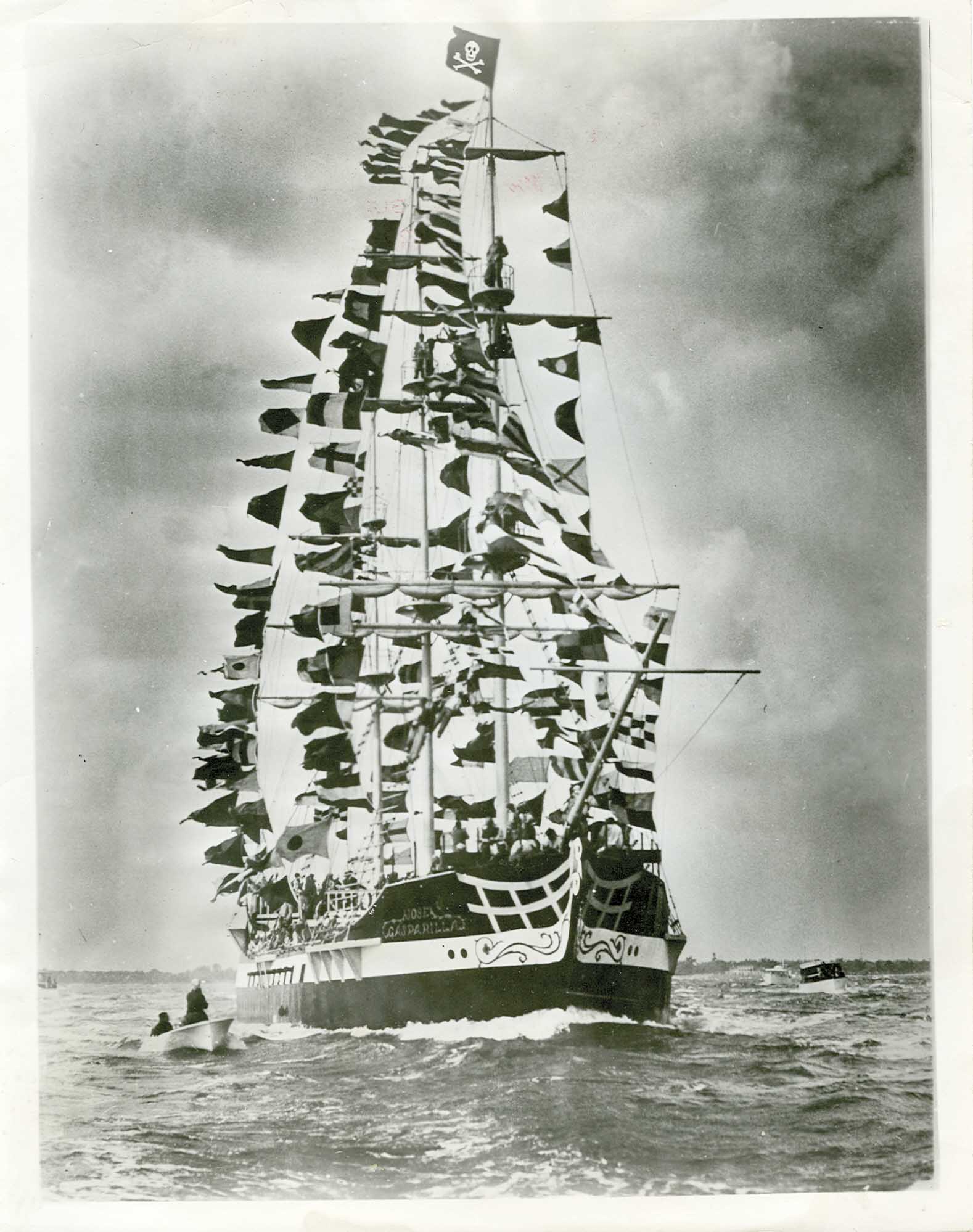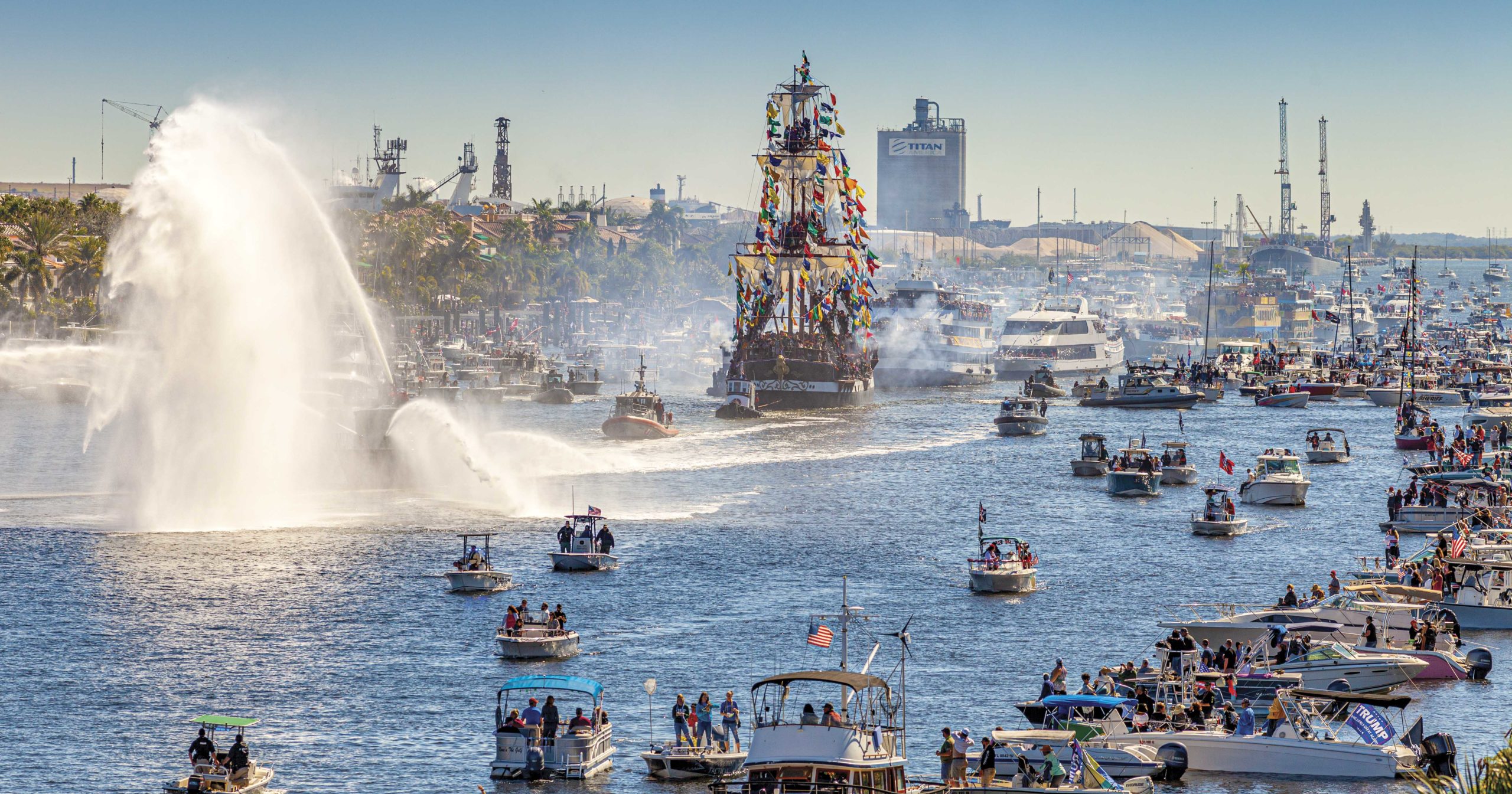Many things can distinguish pirates from the typical brigands, highwaymen or common thieves, but the main one — and the biggest — is the pirate ship. Tampa’s modern pirates, the social club Ye Mystic Krewe of Gasparilla, are no exception, as they have been “invading” the city by ship almost since their first appearance in 1904. The pirate invasion has become a spirited part of the city’s annual Gasparilla festivities, a 90-minute journey from Ballast Point to the Tampa Convention Center, where the pirates “steal” the mayor’s key to the city before the Parade of Pirates begins on Bayshore Boulevard.
That first year their ship, the Octopus, was rumored to be anchored just off the coast, but the public was threatened with death if they attempted to see it. Tampans had to wait until 1911 to see the pirate ship firsthand and the Gasparilla krewe has been entering the city the same way ever since.
The “real” Jose Gaspar, the mythical 18th century pirate on whom the annual Gasparilla invasion and parade is based, had his own ship, of course. Known as the Floridablanca when in the service of the Spanish Navy, Gaspar rechristened her the Jose Gasparilla after he successfully led most of the ship’s crew in a mutiny of the captain in 1783. Twelve years later, he captured a relatively new Spanish merchant ship and christened her the Gasparilla II.
It took 90 years, but in 1911 the modern Jose Gaspar and his pirate crew once again plied the waters along Florida’s Gulf Coast. That first sea-borne invasion by Ye Mystic Krewe took place aboard a borrowed three-masted schooner known as the Samuel T. Beacham. The krewe re-named her the Gasparilla the Fifth, as this was Tampa’s fifth Gasparilla celebration. (Gasparilla started in 1904, but there was no Gasparilla from 1907-09.)

The Feb. 26, 1911 Tampa Tribune carried a complete description of the event, which reads in part, “The entrance in the city of the krewe eclipsed anything yet attempted by this band of debonair and gallant young men… They sailed up Tampa Bay (Hillsborough Bay) in their pirate ship, named Gasparilla the Fifth, which had a large black flag at the bow, a red flag at the mizzenmast and the pirate flag at the main mast, this being black, with white skull and crossbones. At the portholes were cannons.”
The pirate ship did not enter Tampa’s harbor alone. Like today, there was a flotilla (albeit much smaller and tamer than present day, which has become the country’s largest boat parade with about 750 boats). The Tribune continues, “A pretty feature of the entrance in port was the beautifully decorated boats occupied by fair women of the city, who left the Tampa Bay docks, opposite the Tampa Bay Hotel, at 4 p.m. and went forth to meet the pirate cruiser.”
The Gasparilla ship and accompanying boats all docked at the Tampa Bay Hotel docks on the Hillsborough River.
The Samuel T. Beacham again flew under the pirate flag in 1912 as Gasparilla VI, followed in the ensuing years by a variety of ships procured by the krewe, some at the last minute. In 1937, the krewe acquired its first permanent pirate ship, which they named the Jose Gasparilla.

Ye Mystic Krewe invaded Tampa aboard the Jose Gasparilla from 1937-51 (except during World War II when Gasparilla was put on hiatus). In 1952 she was declared unseaworthy and was not used again. Four years later, on the eve of the 1956 invasion, she burned to the waterline and sank along the eastern bank of the Hillsborough River north of Cass Street.
For the invasions of 1952 and ‘53, Ye Mystic Krewe had to make do with several smaller vessels to accommodate the piratical invaders. During this time, plans were made and implemented to construct a purpose-built ship for Gasparilla. The Jose Gasparilla II made her debut during the 1954 invasion – a fitting way to celebrate the 50th anniversary of the first Gasparilla.
Constructed under the direction of krewe member George Lackman, the Jose Gasparilla II is actually a flat-bottomed steel barge. The ship is 137 feet in length and has a beam (width) of 36 feet. Its three masts soar 100 feet from the waterline and during the invasion the rigging is filled with gun-toting pirates.
The Jose Gasparilla II has no means of self-propulsion. Instead, it is towed during the invasion by two or sometimes three tugboats. The ship is maintained by the krewe and it takes one to two months of work (depending on if it’s pulled from the water) every year to clean, prepare and outfit it with flags and other necessities for the annual invasion.

Beginning in 1914 and continuing to today, the ship launches from the pier at Ballast Point, just to the north of the Tampa Yacht and Country Club, and makes its way up Seddon Channel to Downtown Tampa. The construction of the Lee Roy Selmon Expressway (originally known as the Crosstown Expressway) in 1976 prohibited the ship from going up the Hillsborough River.
Since that time, the ship has landed with its krewe of pirates at a variety of locations, including its mooring location along Bayshore Boulevard, the U. S. Customs Station on the lower river and ultimately at the Tampa Convention Center. Regardless of where they land, the pirates of Ye Mystic Krewe disembark their vessel and then lead the city in a grand parade, a tradition that has been going on for 119 years and counting.
Rodney Kite-Powell is a Tampa-born author, the official historian of Hillsborough County and the director of the Touchton Map Library at the Tampa Bay History Center, where he has worked since 1995.
Meet Pete Lackman: 2022 Captain of Ye Mystic Krewe of Gasparilla.



